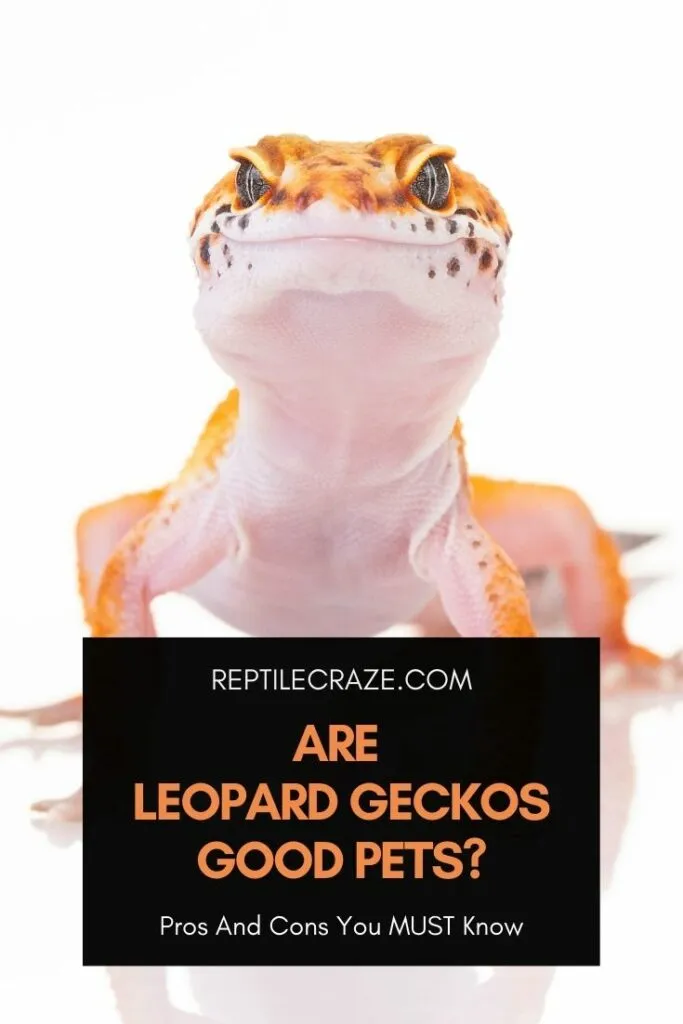
Leopard Geckos are some of the most popular pet reptiles worldwide. I’ve seen them in all sorts of colors and patterns, readily available at physical and online pet stores. If you, like me, are intrigued by these pretty little geckos, you may be wondering if they are good pets.
Leopard Geckos are good pets for anyone that wants an easy-to-care-for reptile. They don’t require much room, live a long time in captivity, and are active at dawn and dusk when most people are home. They come in a wide variety of colors and patterns and are easy to handle.
Leopard Geckos can be great pets for the right person, but they’re not for everyone. Here’s what you need to know about why Leopard Geckos make good pets and why they might not be the right pet for you, as well as some tips for how to make your Leopard Gecko a better pet.
Also, at the end of this article, we have a decision tree that will help you to decide whether a leopard gecko is the right pet for you or not.
| Why Leopard Geckos May be Good Pets | Why Leopard Geckos May Not be Good Pets |
| Easy to care for compared to most other reptiles | May not be particularly active or engaging in their enclosure |
| Don’t take up very much room, only requiring a 20-gallon | Have special requirements in lighting, live |
| Live a long time, typically 10 to 20 years in captivity | More unusual color morphs and patterns can become very expensive |
| Active at dusk and dawn and somewhat in the evening, when many people have time to spend with them | The tail can drop off if it is pulled or if the gecko is not handled carefully |
| Easy to breed in captivity, so buying one does not mean you are depleting wild populations | Unlikely to seek out or return affection, although they may enjoy being held |
| Come in a great variety of colors and patterns | May give you a disease like salmonella |
| Easy to handle and tame |
Table of Contents
Why Leopard Geckos Make Good Pets
Leopard Geckos are Relatively Easy to Care For Compared to Other Reptiles
All reptiles need to live in an environment as close as possible to their wild environment. Unlike cats and dogs that acclimate to our world, reptiles need their own little world in your home.
Of all of the reptiles that are commonly kept as pets, Leopard Geckos are one of the reptiles whose natural environment is most easily recreated.
Whether you want an entirely artificial enclosure or a natural bioactive setup, it is quite easy to provide an ideal environment for a Leopard Gecko. Here are the essentials:
- A heat lamp or pad to create a temperature gradient from hot to cool. They do not technically require UVB light, but providing UVB can make them healthier.
- A secure enclosure with good ventilation and relatively low humidity. For most people, it is easier to create a low humidity environment and keep it clean and free of mold than it is to create a high humidity environment.
- A simple dish of water, unlike many other reptiles, which require a drip system or mister.
- Live crickets, mealworms, wax worms (we recommend reading our guide on wax worms here), and other small insects. Most Leopard Geckos take food very readily.
All told, Leopard Geckos require considerably less special care and fewer supplies than many other reptiles.
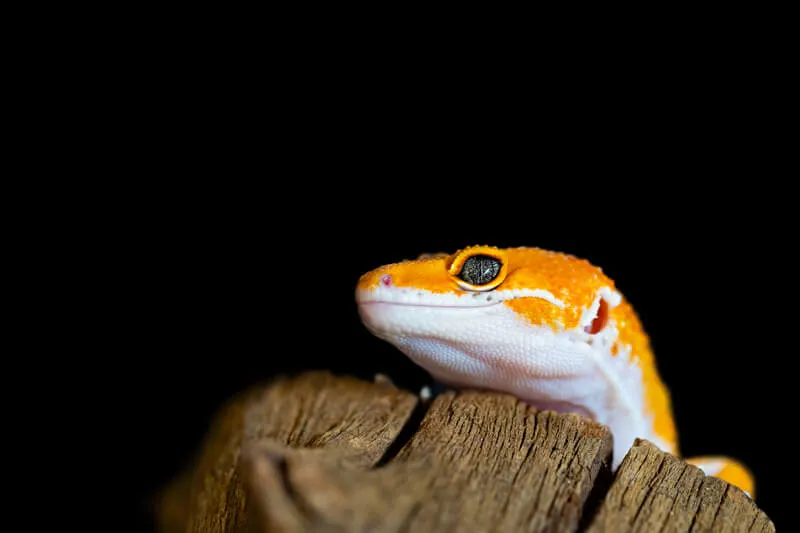
Leopard Geckos Don’t Take Up Much Room
Leopard Geckos take up much less room than most other pets. A young Leopard Gecko or pair of geckos can be managed in a 10-gallon
Because they spend most of their time moving over the ground rather than climbing, a
Leopard Geckos are Relatively Long-Lived
Leopard Geckos can live from 10 to 20 years. This life span, which is comparable to a dog’s, is ideal for many pet owners.
It is long enough for you to get attached to your Leopard Gecko and have time to enjoy them, but it is short enough that you won’t have to worry about including your Leopard Gecko in your will.
Leopard Geckos Tend to be Active at Dawn and Dusk
Leopard Geckos are crepuscular, or primarily active at dawn and dusk. Other than these times, they are more likely to be active at night than during the day.
Since many people are at work or school during the day, this activity pattern is a good match for lots of households.
Leopard Geckos are Easy to Breed in Captivity
Leopard Geckos are one of the easiest reptiles to breed in captivity. They breed readily and it is fairly easy to raise young Leopard Geckos. Most young Leopard Geckos begin taking
For many reptile enthusiasts, the first pet reptile is only the beginning. It’s a lot of fun to breed reptiles and raise the offspring, so choosing a species that is easy to breed in captivity is a big advantage.
Another advantage of the easy captive breeding of Leopard Gecko is that the vast majority of animals in the pet trade are captive-bred. That means that when you buy your Leopard Gecko, you don’t have to worry that you are depleting wild numbers
Leopard Geckos Come in a Wide Variety of Colors And Patterns
Leopard Geckos have been kept in captivity for decades, and over the years they have been bred into a vast array of colors and patterns. You can find Leopard Geckos that are completely white or nearly black.
You can also find Leopard Geckos in varying shades of orange, yellow, and tan. Some Leopard Geckos have almost no pattern at all, while others have stripes or splotches instead of the natural speckled pattern.
Leopard Geckos change color dramatically from the time they are young until they are adults. Very young Leopard Gecko may even have blue or green in their coloration, although this color typically fades as they get older.
Leopard Geckos are Easy to Handle
Most reptiles and especially most geckos are not a fan of being held. However, many people find their Leopard Gecko to be the exception.
Leopard Geckos can be trained to enjoy handling, often in only a couple of weeks. They are relatively slow-moving and most seem to settle into enjoying the heat from your hand or lap in no time.
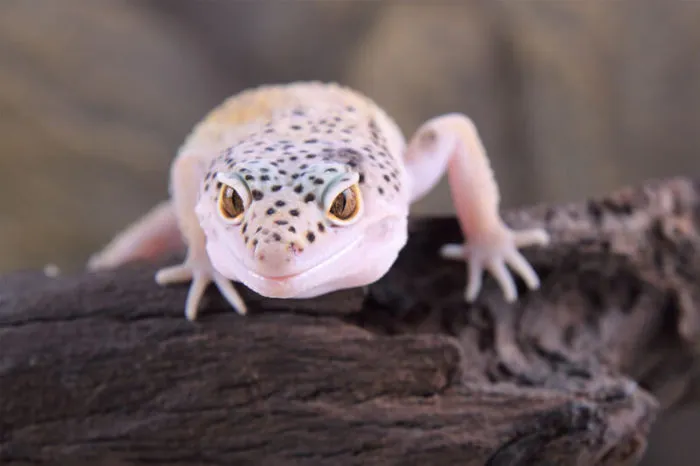
Why Leopard Geckos May Not Be The Right Pet For You
A Leopard Gecko’s Tail Can Drop Off
Leopard Geckos are quite easy to hold and most adjust to taming very readily. However, if you would like them to be a pet for a child, the tendency of the tail to fall off can make them a less-than-ideal choice.
Leopard Geckos will drop their tail if it is grabbed, often even if it is grabbed very briefly or lightly, especially before they are fully tamed.
While the tail can grow back, it requires a lot of resources from the gecko, which can reduce their health. It also tends not to grow back as healthy or fat as it was before.
Leopard Geckos Have Special Requirements
Leopard Geckos are among the easiest reptiles to keep in captivity, but they still have more requirements than many other small pets like fish or rodents. If you purchase only the minimum requirements for your Leopard Gecko, it will still likely cost about $300 to get them set up.
Buying crickets and other sources of
Leopard Geckos typically will not accept anything but live insects, so acquiring and caring for insects is an important part of the hobby.
Leopard Geckos Can Make You Sick
Salmonella is more common in reptiles and amphibians that come from an aquatic environment, like frogs and turtles, but Leopard Geckos can also transmit it. Captive-born Leopard Geckos are unlikely to carry other zoonotic diseases or diseases that may be transmitted to people, but it is possible.
You should always wash your hands carefully after handling a Leopard Gecko. Also be sure to wash your clothes if a gecko is on your lap.
Children too young to avoid touching their face before washing their hands shouldn’t handle Leopard Geckos or any other reptile.
The chances of becoming sick because of a disease Leopard Geckos carry is less than with reptiles that live in an aquatic environment or are wild-caught, but it is a possibility.
Leopard Gecko Color Morphs can Get Expensive
If you have your heart set on a pure white Leopard Gecko, one with tangerine color, or some other morph, be ready to increase the budget that you have set aside for your Leopard Gecko purchase.
While a natural colored Leopard Gecko typically only costs around $20 or $30 or even less, more rare color morphs are considerably more expensive.
A Black Night Leopard Gecko with nearly entirely black coloration can run you up to $3,400, which is a considerable investment for your pet lizard.
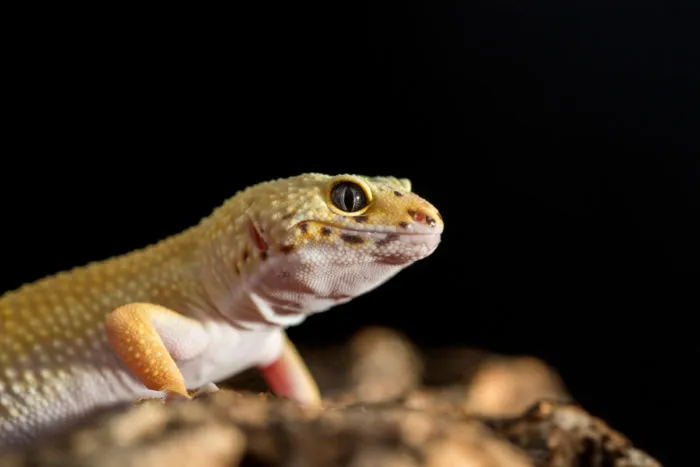
Leopard Geckos Are Not Particularly Active
If you want to enjoy watching your pet reptile explore their enclosure and interact with the environment, the Leopard Gecko may not be the best choice for you.
Leopard Geckos do become active at dawn and dusk and spend some time exploring, but they do not spend most of their time exploring every nook and cranny of the environment like some other reptiles.
They also tend to interact with the glass in less than appealing ways, like rubbing up against it or pushing their head against it.
Leopard Geckos are Less Likely to Show Affection than Some Other Pets
Leopard Geckos can absolutely be tamed and many people believe that their Leopard Geckos enjoy being held and soaking up the warmth from their hand or lap.
However, you shouldn’t expect your Leopard Gecko to show affection or seek out interactions from you the way that a cat, dog, or even rat would do.
How to Help Your Leopard Gecko be The Best Pet it Can Be
Some people find that they are happier with their Leopard Gecko as a pet than others. There are a number of things that you can do to set your Leopard Gecko up for success in being an ideal pet for you:
Tame Your Leopard Gecko Carefully
When you bring home your baby Leopard Gecko, you will surely want to begin building a bond with it as soon as possible. However, you want to be very careful not to rush it, as trying to go too quickly can traumatize or injure your Leopard Gecko.
Baby Leopard Geckos are fragile, faster than adults, and more likely to be skittish. Therefore, it is best not to try to hold your Leopard Gecko outside of the cage until it is at least 6in long.
That doesn’t mean you can’t get to know your baby Leopard Gecko and begin building a relationship. Here are a few key points to help you socialize your baby Leopard Gecko:
1. Keep your Leopard Gecko’s cage somewhere you spend time
If your Leopard Gecko’s cage is in a rarely-used room, it is unlikely that they will get used to you and your movements around the cage.
Your baby Leopard Gecko may be startled by your movements for a few days, but after a little while, you will find that they don’t react to you moving around.
Your gecko may even come to the front of the cage when you are around in hopes of getting a snack.
2. Associate yourself with good things for your Leopard Gecko
The most important thing in your young Leopard Gecko’s life is
Many people hand-feed their Leopard Gecko babies to build an association between good things and people. If you are going to hand feed your Leopard Gecko, use tweezers or tongs so that your Leopard Gecko won’t begin to associate your fingers with
Another great tactic is to make a distinct sound while you are feeding your Leopard Gecko. You can talk to your Leopard Gecko so they associate the sound of your voice with
If you always repeat this sound when feeding your Leopard Gecko, they will soon come running when they hear it in expectation of a meal.
3. Let your Leopard Gecko become familiar with your hand
When your Leopard Gecko is still a baby it’s too early for you to pick them up, but that doesn’t mean that they shouldn’t choose to be on your hand.
Put your hand between your Gecko and their
Be sure that your hands are clean and free of chemicals since your Leopard Gecko may lick your fingers to get a sense of the environment.
4. Handle your adult Leopard Gecko
If you have had your Leopard Gecko since they were a baby and followed the previous steps, your Leopard Gecko will already be very comfortable with your hand and with you by the time they are big enough for you to pick them up.
To get your Leopard Gecko comfortable with being handled, make the sound that they associate with
Over the course of the next week or so, gradually increase the length of time that you hold your Leopard Gecko every day. Soon, you’ll find that your Leopard Gecko is completely comfortable when you pick them up.
At this point, you no longer need to feed them directly after being handled, but it’s a good idea to maintain an association between good things like
Here is a great explanation of how to tame your Leopard Gecko once it is big enough to be handled:
Set up a Low-Maintenance Enclosure for Your Leopard Gecko
One thing that can quickly sour you on Leopard Gecko ownership is having a stinky enclosure or having to spend a lot of time cleaning the enclosure.
Setting up a low-maintenance enclosure that cleans itself naturally can increase your enjoyment of your Leopard Gecko, make your gecko healthier, and make it easier for you to maintain their cage.
While Leopard Geckos can be maintained in an entirely artificial enclosure, many people find that their geckos do better in a bioactive setup.
It may seem a bit more difficult to set up a bioactive enclosure initially, but in time, you’ll find that it more than makes up for itself in how much less you have to clean.
Bioactive enclosures have living plants and insects. These types of enclosures have natural higher and lower humidity areas, so your Leopard Gecko can seek out higher humidity when they want to shed without you having to bathe them or provide a humidity box.
Perhaps most importantly, the insects, known as a clean-up crew, eat any mold that grows in the enclosure and will also consume your Leopard Gecko’s waste, including feces and shed skin. They will also eat any insect remains leftover from feeding.
Because these insects clean up continuously, the cage is much less likely to smell, and you won’t have to spend as much time cleaning. In fact, many people find that they never have to clean a bioactive setup at all.
Isopods and springtails are the most common insects to use in a bioactive setup, but many more can be used as well. Some, like white worms and bean weevil larvae, can also provide a
Having live
Many people find that bioactive enclosures are more interesting to observe as well as being easier to maintain and result in happier, healthier geckos, which in turn makes your Leopard Gecko a better pet.
Here’s a great explanation about how to set up a bioactive environment for your Leopard Gecko:
Is A Leopard Gecko the Right Pet for You?
For the right person, Leopard Geckos can make wonderful pets. Their relatively conservative needs, particularly for a reptile, make them a great pick for all kinds of people.
If you need some more help to decide whether or not a leopard gecko is a good pet for you, have a look at our decision tree below!
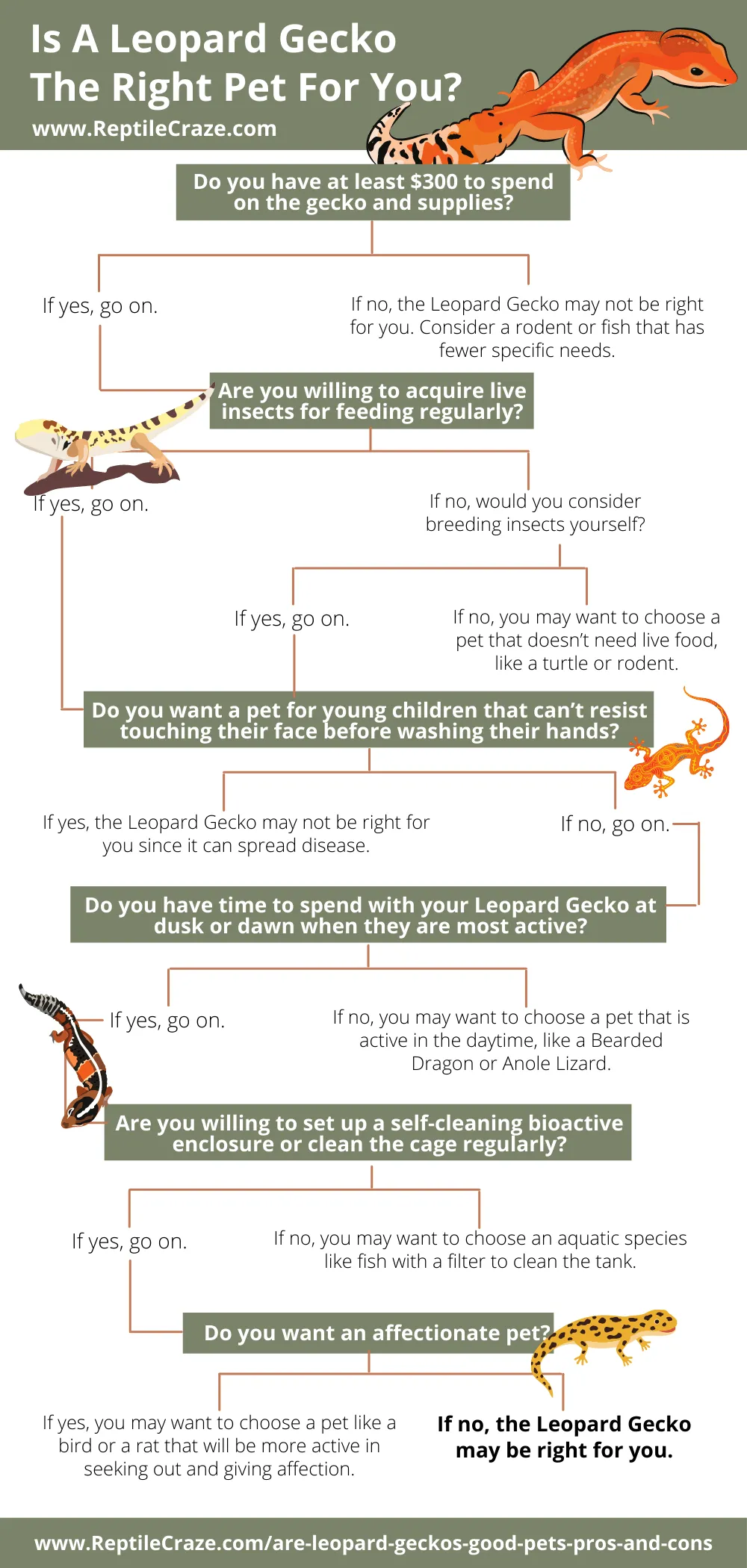
However, Leopard Geckos do have some special needs and some limitations which means they aren’t right for everybody.
Think carefully about what you want in a pet and what you are able to offer your Leopard Gecko to help you decide whether this is the right pet for you.
- Enchi Ball Python: A Unique and Stunning Morph of Python regius - March 27, 2025
- Emerald Tree Monitor: The Enigmatic Green Guardian of the Rainforest - March 26, 2025
- The Egyptian Cobra (Naja haje): A Fascinating Serpent - March 25, 2025
